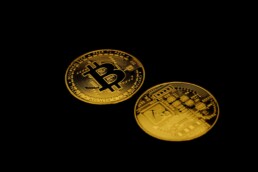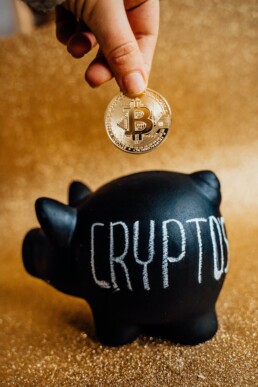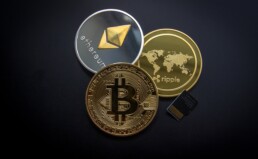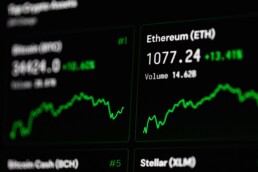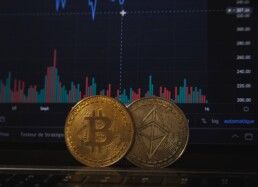How to buy a cryptocurrency - Rookies Step
Today we are going to see how to buy a cryptocurrency in 3 simple steps.
phase 1 - Research:
Before doing anything you have to find out what you want to buy.
Which seems trivial, but it's not so easy to find because the crypto market offers a disproportionate number of coins.
First of all we need to understand if we want to buy a coins with a glorious past or a coins that have just come out on the market.
We need to make this research, which can also be based on suggestions given by the media or friends.
Be careful in this case not to be fooled by possible scams.
Analyze the situation of the coin on a graphical level and everything that revolves around it.
phase 2 - SAFETY
Once you have chosen the coin you want to buy, the first thing to do is find a secure wallet and create it.
Learn more about safety here.
step 3 - buy the coin
Open the exchange and press the BUY button.
Now some recommendations
Always do extensive research on the coin you are analyzing and if someone has suggested it to you, try to understand if it is a disinterested suggestion or not.
Obviously NEVER follow the hype.
The hype invariably leads to entering at inflated prices and then losing a lot of money. Enjoy the hype by standing at the window.
Remember that wallets are programs to hold your coins so pay attention to the different types of wallets and different types of addresses.
If you get the wrong address you have lost your coins.
Bitcoin halving in May 2020
The bitcoin halving is an event that occurs every about 4 years and halves the remuneration of closing a block of the Bitcoin blockchain. It is one of the main features of bitcoin monetary management.
In order to better understand what we are talking about, however, we must review 3 fundamental points which are:
Bitcoin blockchain
Mining
And the total supply of money
Talking about the BlockChain, it is a live record of all bitcoin transactions. The blocks are made up of the transactions within them, and the blocks are linked together in an indissoluble way.
The block is created when a defined number of transactions are made and the block can contain a maximum number of that transactions. Reaching this number, the block is closed and added to the block previously mined and linked to it.
When a Bitcoin transaction occurs, the data is communicated to the network of computers that validate the transaction, add the transaction to the bitcoin ledger and transfer the ledger change to all computers on the network. Since there is a maximum of data that can be saved in a block, a block is closed approximately every 10 minutes
Mining is how transactions are verified within the coin network. The verification and creation of the blocks is created by the miners. Each group of transactions has a cryptographic hash of the previously published block and this connects all to the previously created blocks creating the blockchain. To accept a new block on the network, miners are required to follow a proof of work system that involves the creation of a new cryptographic hash to add to the new block. To be added to the register requires the creation of a new single hash which will go through a validation process and then will be passed to the next block and so on. To create a new hash, miners compete with each other using the computing power of their computers to be the first to have the 64 digit hexadecimal number or hash that is at the same target difficulty level as the network.
The thing to understand is that the miners are remunerated at the closing of each new block with new bitcoins created by the system and by the transaction fees, which are already circulating btc. The rewards are created to incentivize miners to participate in the bitcoin blockchain.
Learn more about Mining here..
The amount of money.
Bitcoin was created as digital gold. Satoshi deliberately created bitcoin with characteristics similar to the physical gold. The principle of mining bitcoin is similar to gold mining, which is long and difficult. Another feature is the maximum amount of bitcoins that can be created which has been programmed to be 21 million. This number was created to copy the inflationary stability of gold. In this case, the term inflation is used for the growth of the amount of money that is not covered by gold in a gold standard.
In the modern way of understanding the term inflation, bitcoin is deflationary because his purchasing power grows over time. Compare it to the gold extraction profile where in the future the cost of extraction will be increasingly higher and more difficult and therefore the previous quantity of gold extracted will increase in value because no more can be produced at low prices.
In the old concept of inflation, bitcoin is inflationary because, not being covered by gold, the quantity of bitcoin grows as the creation of blocks by miners increases. There are now 18 million in circulation. At the current rate, the last bitcoin will be created in 2140
Let's go into the halving detail
The halving referred to the bitcoin blockchain is the reduction of the closing reward of a block for miners to half the previous number. The current reward is 6.25 bitcoins per block.
The halving takes place every 210,000 closed blocks and therefore more or less every 4 years since a block is closed every 10 minutes. Initially, the block reward was 50 bitcoins, which dropped to 25 in 2012 and then 12.5 in 2016
But why does halving happen? Satoshi planned halving to lower bitcoin monetary inflation. In addition, the technological advancement factor of mining machines is also considered and for this there is an increase in the difficulty of creating new blocks to lower the validation speed.
With 12.5 bitcoins per block and 10 minutes of build per block, around 1,800 bitcoins are created daily. After May 2020 these dropped to 900 bitcoins per day.
Now returning to the previous parallel with gold.
It is considered one of the best stores of value due to the fixed presence and its scarcity which is imposed by nature.
The bitcoin algorithm is created to make it scarce. So as the demand for bitcoin grows, the value will grow. There have been major rises in btc prices months after each halving, but this is a trading strategy that you may or may not consider.
Bitcoin as it is created in its algorithm, is made to be scarce and therefore grow in value as long as people like you and me believe in its intrinsic philosophy.
Bitcoin Fees
Bitcoin fees are the payment method decided to pay miners for processing the transactions that are made on the bitcoin blockchain. However, to understand how the fees are calculated, we need to consider what happens when we send bitcoins to another address
When we send any amount of bitcoin, the first step is the verification of the transaction, when the transaction is checked by all the computers that have a copy of the distributed ledger. These computers called nodes check the history of our bitcoins, checking that they are really on our address. After that, once the transaction has been completed, it is inserted into the mempool or memory pool.
To better understand, the mempool is like a waiting room of a virtual airport, with all the transactions waiting to take the plane to enter in a block, or a miner that picks up them and locks them in one of the blocks of the blockchain.
Now the transaction is considered unconfirmed despite being valid and included in the list of transactions that took place.
The transaction is confirmed when a miner takes the transaction and places it in a block and the funds are transferred when the block is closed.
Always remember that blocks have a specific size. if we were in a period in which many transactions take place, obviously the miners will give priority to transactions with higher fees.
So Fees are a way to tell the miner how urgent your transaction is. Faster speed need higher fees to be paid, which are always paid by the sender and there is no way to avoid pay them.
In case we want to calculate the fees, we must remember that the transactions have a size, as if they were files stored on your computer so the miners who want to maximize their earnings, will prefer transactions with a high fee but low weight.
The size of a transaction depends on several factors:
The first factor is the number of inputs.
The bitcoins we have in our wallet are a sum of the bitcoins we have received over time combined with those we already owned on this wallet. This sum is called inputs. When we send bitcoins to someone, we select some of these inputs sent by others and transform them into outputs.
Now, the more inputs a transaction has, the greater the size.
A second factor is the number of outputs, the number of addresses we are sending to.
If we are paying to a single address, we are creating two outputs, one for the address it sends and one to receive the rest of the initial payment.
In fact, if our bitcoin account is a sum of inputs from different sources, these inputs cannot be spent in part but must be sent in their entirety to the receiving address and we will receive the rest on our wallet without realizing it.
Let's assume we have a wallet with 3 bitcoins, formed by two inputs of 1 and 2 bitcoins. In case we have to spend 1.5 bitcoins, our sending will be 2 bitcoins with the remainder of 0.5 going back to our wallet.
Another important factor to consider is the complexity of the script. Some transactions use special options such as multi sig, which increase the size of the transaction for the average user, calculating the size of the transaction is quite difficult but don't worry, our wallet will take care of it and will also suggest the most correct fees at the time of sending.
It should be remembered that the blockchain does not mark the cost of the transaction explicitly. If you want to mark the costs you will have to check it specifically
There are ways to reduce bitcoin sending fees:
avoid sending bitcoins when it is rush hour on the trading markets. If we are in the middle of a bitcoin pump or a dump, with great volatility there will be a lot of movements between trader wallets and exchange wallets. Those in hurry will put higher fees so the price at that time will be higher.
In addition, you can use a segwit wallet that lowers fees and transaction sizes.
In the event that the fees are absolutely crazy, you could use other coins that have much lower costs such as Ripple for example.
Obviously there would be other costs related to the use of exchanges. In this case, the atomic swap comes to help. Do your math before testing this solution.
As already mentioned, most wallets give suggestions and indicate which are the most suitable fees for the moment in which we are operating. Pay attention because there are also wallets that charge too much, so also on this aspect a specific search must be made for the best product. Generally it must also be said that the most advanced wallets give the possibility to choose different options, more or less fast and expensive.
However, if you are stingy, and you don't pay enough fees, it sometimes happens that transactions are blocked just because the fees are too low and no miner is interested in your transaction.
in this case what to do?
the available options are to wait at least 72 hours or use an RBF replace by fee system, which allows the wallet to replace low fees with higher ones but beware, not all wallets support this option.
Hypothetically, a transaction cannot be blocked forever but it really depends. In fact when we talked about mempool at the beginning of the video, we didn't specify where the mempool is. It is not only one but each node of the network has a section dedicated to it, different nodes have different versions of the mempool.
If a transaction is not confirmed, it is deleted from the mempool, the ordinary cancellation time is 72 hours.
However, it may happen that the node where the mempool resides with your transaction does not delete it.
Fees are a big problem for Bitcoin and they can be for you too if you move large amounts without thinking about it.
Learn more about safety here.
Trading vs Investing, with Bitcoin
In this article we talk about bitcoin trading, specifically seeing the difference between investing and trading.
First of all we need to define what bitcoin trading is.
Bitcoin trading is the exchange of fiat currency or other cryptocurrencies for bitcoin, on an exchange, with a short-term vision and then returning to fiat currency by exploiting the high volatility to gain in fiat currency.
We must understand that the difference between investing and trading refers specifically to the long or short term view. In fact, investing means buying bitcoin today and then reselling it in 3 4 or more years, regardless of its movements. Trading bitcoin, on the other hand, means taking advantage of its movements to make money.
The two views are both correct and are the result of two different points of view. Investors generally believe in the underlying technology and ideology of Bitcoin, seeing in it a possible bright future for the asset. Traders, on the other hand, may not be interested in technology but are interested in the short-term economic potential of the instrument, so ups and downs are welcome when positioning in a trend.
The two visions can be experienced simultaneously. Nobody forbids you to put some bitcoins away on a wallet for the long term and at the same time trade others for the short time.
A popular slang term in the bitcoin world is hodl, which refers to someone who has long-term invested in bitcoin. The term comes from a mistake that has become popular on the bitcoin talk forum.
At every big down fall, don't panic and hodl!
Traders not interested in bitcoin technology consider it an interesting asset for their work as the market is open 24 hours a day all year round. The volatility of the currency and its riskiness are the perfect fuel for day traders and swing traders.
One last observation. Don't turn a short-term trade into a long-term investment just because the market has gone in the opposite direction to what you thought and your loss percentage became important because you didn't use the stop loss.
Exchanges and Order
Exchanges are the places where sellers and buyers meet together. This online sites are dedicated to the trading of various cryptocurrencies.
There are various types of exchanges, from the largest and most established with users from all over the world to the smallest ones that have a predominantly regional audience, as it happens in Japan and Korea.
The main features that interest us in an exchange are which coins are traded, the volumes and costs of the exchange and the safety of the sites.
Security as you well know is the fundamental factor of this world, and it weighs on your shoulders.
Exchanges work just like the stock exchange and manage your money. There is an order and sales book, you will have your own personal wallet but owned by the exchange. With some of these wallets you can even make loans to other users and get paid.
Now, there is no 100 percent secure exchange and these entities are in the hands of companies that obviously have profit as their reason for existence. Exchanges can be attacked by hackers or they can scam users, blocking funds and running away with money. For this reason you will have to leave as few coin or currency as possible on the exchange.
The largest exchanges are structured to resist to attacks and attempted robberies, but the provision is never too much. Each exchange takes care to put you in a position to protect your account, so don't be lazy and take the necessary actions to protect yourself
Moving on to coins, here we have another difference. In almost all exchanges bitcoin is traded but some small coins, with very low volumes and illiquid, are traded only on one or two exchanges in the world. This forces us, if we want to betray them, to rely on these actors who are unknown to most. In this case we will have to read the rules of these exchanges because they may not allow the exit of funds below or above a certain value, or forcing us to go through the kyc procedures and this may take a long time to be resolved.
The volumes of an exchange are an important signal, meaning that that data coin on that given market is very or little sold and in demand. Many volumes equate to many buyers and sellers, therefore a market rich in money that is defined as liquid. Small exchanges with low volumes are therefore illiquid.
Each exchange has usage costs, check them before deciding on which exchange to operate more often.
Also remember that although bitcoins are all the same, on different exchanges they are sold at different prices, giving rise to arbitrage phenomena.
When you go to trade on exchanges, you will have different types of orders to buy or sell. Let's see some of them.
Let's start with the simpler than the market order or market order. In this specific order, the purchase takes place at the sale price of the lowest asset and the order is not stopped until the requested quantity is reached.
Let's take an example. I purchase 20 ethereum with a market order. At that moment on the book, the first lots on sale at the lowest price will be 10 ethereum at $ 200 and another 20 at $ 210.
With this order I will buy 10 ethereums for $ 200 and another 10 ethereums for $ 210. With this order, the price does not matter, but the quantity indicated.
In the case of a sales order of this type, the behavior is the same.
Another kind of order is the limited order. In this case, when we go to create the purchase order, we enter the quantity and the decided price. In this case we can put a price slightly below that of the moment or much lower, it all depends on how we see the situation on the market. This type of order could be either unfulfilled or partially filled.
Again using the example above, if we placed an order for 20 ethereum at $ 200, with a current price of $ 210, we would have to wait for a descent to ensure that the order is executed. It could happen that only 5 ethereums on the market sell for $ 200, so our order would be partial.
Also in this case when the behavior of the order in the event of a sale is the same. Price and quantity will be fixed and may not be reached.
A more complicated type of order is the stop loss order. This kind of order incorporates a sales strategy that wants to cut losses, a stop loss in fact. When the trend is uncertain you can use this order to protect yourself.
In case we still have an order like this for 10 ethereum at $ 200, with a stop loss at $ 190. If our long view is right, from our purchase at $ 200 ethereum it will go up in price and at the right time we will take profit. However, if we made a mistake and ethereum starts a negative trend, our order will automatically sell the position at 190 dollars, saving our account.
Viewed from the point of sale, this type of order can be changed with a higher price which turns into a take profit. If ethereum begins a slight positive trend we will be able to move the stop loss in equal to $ 200 or if the rise is more pronounced the figure could be even $ 210 and beyond. In this case we would continue to have a position within an uptrend that would be sold for a gain in the event of a reversal of the trend.
Bitcoin Lightning Network
Lightning Network is one of the solutions for one of the problems of bitcoin.
Lightning Network is a system created on top of the Bitcoin blockchain, with specific rules, to have fast and fee-free transactions.
We all know Bitcoin is cool but it's not perfect. Bitcoin has limitations such as the speed and cost of transactions.
In a particularly dense period of transactions, not high enough fees and blocks every 10 minutes, can make your purchase or move from one wallet to another really slow and expensive.
Lightining network should solve all these problems. The concept of this system has been developed since 2015 and we have to imagine that it works as if it were a layer cake.
On layer 1 we have Bitcoin with the blockchain while on layer 2 we have the lightning network system.
This feature is created specifically for micropayments, so that all micro transactions are not written on the bitcoin blockchain. At least not immediately.
The payment channels are created so if I want to send funds to a friend of mine or to a shopkeeper we can open a payment channel between the two of us, with our payments not involving the main blockchain. the transaction will take place at the speed with which the two wallets are able to communicate with each other.
When the transactions between the two wallets are complete, a main transaction will be created and written to the main Blockchain.
Now, if we thought of a series of regular, small-scale transactions, such as coffee at the bar every morning, each transaction sent to the main bitcoin blockchain would cost us more in lost time and fees than the transaction itself. Does it make sense to spend 10 dollars of coffee and 20 on commissions?
NO
Now let's imagine opening a payment channel for my entire CY Mood team with my favorite bartender. Upon opening the payment channel, both parties deposit a certain amount of money to guarantee the total transactions. If I know my team drinks 100 coffees a week I will deposit an equal or greater amount.
On the main Bitcoin BlockChain there will be only 2 transactions, namely the first transaction to open the payment channel and deposit the coin and a second to "close" or complete the payment
Now if we go back to our second layer, thousands millions of transactions can take place within the payment channel without these being written to the main blockchain. My team will be able to drink thousands of coffees and every time they buy, they will write an X BTC transaction to the barista
Weekly, monthly or every time my barista friend wants to cash out the coffee bitcoins, he will decide to write the transaction on the main BlockChain.
The system works best for small repeating transactions, we can think of our baker or the barber. There is obviously a system against scams, for those who want to close the payment channel in advance and not pay anything. In this case, the total of the initial deposit would be sent to the scammer. This greatly discourages scams.
Another interesting ability of the Lightning network is the ability to make payments to people with whom we do not have an open channel, but using other people's channels.
Being exposed in crypto consciously and knowing the dangers.
Why investing in cryptocurrencies? Why starting to study a whole new environment with a huge initial difficulty? Why endanger that part of our assets that we have decided to allocate in cryptocurrencies?
Because yes.
We start from the idea that the world of investments as a whole is huge, and that Blockchain is currently the most recent technology and with the greatest growth push on the planet. Investing in blockchain projects is within everyone's reach, so even less capable investors with little experience or just beginners can invest. Investors of this type are the ones who will make the biggest mistakes so they need to understand the various projects and decide if they are worth our money.
If you remember the dotcom bubble, you could have invested in amazon or google or other realities of the early internet era ... But we only remember those who survived and we forgot all those realities that had stratospheric growths in a few weeks, and then see your stock value crash to the downside and disappear from the market. But only from the market, not from the sad and shocked minds of their investors ...
Let's forget for a moment Bitcoin and Ethereum which are now the two champions of the crypto world, the universe of Blockchain projects is huge and varied.
It should be immediately understood that there are many projects that are or have turned out to be exclusively scams or clones of other more noble and serious projects, which with scammy name and various tricks have simply tried to drain funds from inattentive and inexperienced investors.
Currently over 90 percent of blockchain projects launched and funded have failed, most without writing a single line of code. Aware of this, and also aware of the fact that the Blockchain is the future and it is time to be inside it, as investors we must ask ourselves some simple and basic questions to understand where to put our funds.
Let's start with the first doubt to be eliminated, if the project we are evaluating creates a product or service that solves a real problem and if this is in line with Blockchain technology. Not all projects showed off as crypto friendly are suitable for the Blockchain. In case it is really suitable, and perhaps thanks to the blockchain it solves an unsolvable problem, well we have taken a big step forward. Those who do not respect this rule can be eliminated in a long-term investment perspective.
After that we will have to understand if the evaluated product really exists or is still under development or worse, it is only on paper and not even explained in a perfectly understandable way. In fact, a product under development takes months if not years to be launched on the market, extending the time for the return of the investment and therefore enormously increasing the risks for the investor.
After the product, the team should be checked. It is clear that the team must reflect experience in the sector to which the project belongs and the individual members must be experienced and competent, with a good curriculum. The team will then have to try to create partnerships with various companies already on the market. Experience, partnership and reputation are excellent indicators.
Another aspect to check is the type of token created to finance the project and offered to the public. There are utility tokens that offer a service linked to the project and whose value changes according to company and market trends. Otherwise, security tokens can be offered, which are backed by real company assets. These tokens are regulated and, in addition to offering an extra guarantee on the project, they carry rights on assets owned by the company.
Another point to check for the investor is the control of who issues the token, whether through an exchange or directly by the company in charge of the project. In the case of little-known exchanges with an unclear past, here is an alarm bell.
And this point makes us shift our attention to the dangers of investing in cryptocurrencies. Danger seen as the possibility of losing all our accumulated value.
First of all we need to define and differentiate the types of risks we run by investing in crypto.
We have two main type of risk, which are technical risk and financial risk.
When we talk about technical risk, we mean any problems we may have with wallets, exchanges and other technological issues.
The wallet is your property and it is your responsibility to manage it in the best possible way. One of the things that you cannot predict, however, is a possible bug that cause to hack the wallet and make you lose your funds. For this reason, the best choice to always make is to look for and use only the most successful wallets created by companies that invest a lot in security for their products. This choice is yours and it is your responsibility.
The same goes for the choice of the exchange on which to operate. An exchange can be attacked and its wallets can be hit and looted. But a large exchange has the funds and a strong need to protect itself, so it will always be state of the art in protecting its business and consequently its users. On the other hand, small exchanges do not always have these capabilities and are much more risky. The risk you take, however, can be rewarded since small exchanges often have coins that are not present on the larger ones and the movements can be more violent and faster, making you gain or lose more.
Leaving your coins on an exchange is a big risk. Remember that the coin that is on your wallet on the exchange is in the wallet of an exchange and not on your proprietary wallet. If something should happen to the exchange, you are almost certain that you have lost your parked coins waiting to be traded. In my experience it is better to spend something on movements from and outside your wallet. You run the same risk when you borrow your coins on an exchange that gives you this option. In this case, however, the risk is greater since your coins will be blocked for the entire time of the loan, not allowing you to quickly exit the exchange for whatever reason you want. It should also be considered that exchanges do not always allow immediate exits since the general timing is between 12 and 24 hours.
Scams are a full-blown reality of this world, we have made an article with the list of the most famous so we can teach you how to defend yourself. Learn more about Scam here.
Another problem you may find is the technological protection of the coins. Coins like Bitcoin and ethereum are difficult to attack, the development teams are very large and made up of capable programmers with very large budgets. On the contrary, coins just put on the market and therefore small and with few developers could have bugs that undermine their intrinsic safety. Choosing the coin to invest in is your responsibility, you take a risk in any case but it is a risk that you can manage.
Therefore the risk is reduced by using high quality wallets, exchanges of proven trust and coins among the most liquid. If you use the right things in the right way you have lowered the problematic risk.
Now let's face the financial risk.
The major problem encountered in the crypto market is the extreme volatility of prices, given by a combination of low market liquidity, thin books and a strong presence of whales that can move the market. However, this volatility is the key to making money. If we position ourselves in the right trend, our coin will obviously have a growth that is impossible on conventional markets.
But be careful, there are no guarantees regarding the growth of the price of a coin. It is not acceptable to buy something at random and abandon it, and then hope that in the following months or years it will increase in price.
The same goes for the underlying of each coin. The underlying of each coin is the development and use technology that it has in the real economy. If this technology is useless, wrong or totally non-existent, it is obvious that the value could collapse and reach zero.
There are Ponzi schemes like OneCoin which have no underlying and which are based only on the trust placed in them. When confidence collapses, OneCoin is like a fake baseball card. I only mentioned OneCoin for the trust issue, OneCoin is not a cryptocurrency.
Bitcoin has value because people believe in this technology and believe in the monetary design philosophy that underlies it. Bitcoin is also valuable because it is used according to its philosophy. The use of a coin, like the trust that the public has in it, creates value on the market.
There are some basic things that you must always remember.
By investing in anything, you are taking a risk. Risk that you can lower but never eliminate. Balance the risk on your profile, never overshoot it. Every mistake is always paid with your money.
In the long run there are no certainties about the value, while someone more famous and better than me said that in the long run we are all dead.
The risk of losing and zeroing your trading account is as real in crypto currencies as on any financial instrument. On crypto and derivatives, obviously all this can happen very quickly.
Anyone who promises you fast, safe and risk-free earnings is lying and wants to scam you. Say goodbye to this fool.
Virgin BTC- A brand new Bitcoin...
Speaking of mining, you also need to know what virgin bitcoins are.
A virgin bitcoin is a bitcoin that has just been mined or that has never transacted on the blockchain or that has a certified transaction history.
In the world of cryptocurrencies, many scams have occurred against bitcoin users, while other bitcoins have been used for illegal activities, theft or money laundering.
Since the blockchain is visible to all, it is possible to track the history of every single bitcoin by checking its transaction history. Which is difficult but real.
The authorities of a country could keep an eye on some wallets with bitcoin inside involved in criminal actions. In this case, if these were passed on the wallet of some exchange, they could be blocked or not accepted by the exchange.
This can create concerns and some financial intermediaries may not accept bitcoins of non-certified origin.
And here a Bitcoin without transactions is very useful and therefore its price will be higher than a normal bitcoin, in the order of 20 or 30 percent more.
The increased regulatory push drives the demand for virgin bitcoins.
Bitcoins without a clean history are not to be considered dirty or unused but we simply don't know what their life was like before we had them in our wallet. Life that may have been extremely adventurous
Blockchain protocols: investors point of view
In previous articles we have seen that there are different types of coins and therefore there are different ways to create them, or rather, to mine these coins. Learn more about mining here.
With different protocols for creating coins, from the investor's point of view we have another feature to be studied before making any purchase.
In fact, cryptocurrencies investors must analyze the blockchain protocol before investing in coins. Consensus algorithms can be the key to success with effects on inflation rates, security and the total value of the currency. Learn what is a Blockchain here.
But what is a Blockchain protocol?
A blockchain protocol is the common term for defining consensus methods.
Consensus methods are different systems created to reach consensus and validate transactions in a blockchain network.
Some require miners to hold coins, others require hardware to mine such as computers or graphics cards.
We know there are 3 types of consent which are:
Proof of work, proof of stake and delegated proof of stake
Let's briefly see some details:
Proof of work: from energy to value
Bitcoin and other coins use Proof of Work (PoW) as a consensus algorithm.
In the PoW consensus type, miners participate in the network by adding large amounts of computing power.
Big miners create physical mining rigs, consisting of several graphics cards in series, if not hundreds.
More powerful platforms equate to more chances of closing the next block and receiving the next block's reward coins.
Blockchain Transactions also include transaction fees.
So, in this case, the miner has to buy a large number of expensive graphics cards, spending a lot of money before earning a single bitcoin (or any other currency).
Miners can create a mining pool to combine their computing power and add more chances of receiving rewards.
In the proof of work economy Miners must spend thousands of dollars to build computer technology plants and pay high electricity bills to participate in networks of this type of blockchain otherwise, there would be no currency and no blockchain
In theory, these costs should add great value to a PoW coin
Miners don't want to sell coins below their mining cost
If you want to find out the minimum cost of a coin of this type, you need to look:
- The cost for miners to mine new coins (rig + electricity)
- The time to create a block and its reward
Let's take an example. If we have a PoW scheme with:
- Quick block creation times
- High reward
- Low total amount of money offered
Then the total supply will reach its maximum rapidly. As long as the demand for money is high, the currency should perform well. Otherwise you can see how the market reacts and wait until all the coins are created.
In another PoW scheme we have:
- Slow block creation times
- Low reward for blocks created
- high total money supply
In this example, the inflation rate is low due to lower demand. The coin will be profitable as long as it is new and scarce on the market.
Proof-of-Stake: no more platforms and computers
Proof of Stake or PoS does not require the purchase of mining rigs or the payment of huge electricity bills
The POS is a very different consensus model that allows all coin holders to contribute to the network and block building
You have to keep the coins in your wallet, activate staking and leave your computer on and you will receive rewards by acting as a miner
In this way, the Pos is a great incentive to hold coins also because the more coins you have, the more you contribute to the network and the more you have the chance to solve the next block.
So, in this case, miners have to spend a lot of money to buy coins to stake.
This is much simpler and faster than the proof of work protocol
The only available metrics are total supply, current supply, inflation rate, and current market price. So, you can analyze this market in a similar way to a fiat currency by measuring supply and demand.
DPOS Delegate proof of Stake with reliable nodes
This is a variation of the classic POS.
In this protocol, all coin holders elect delegates.
These delegates are the only ones authorized to verify and add new blocks to the blockchain.
In this case we can have a centralization of the first users with many coins. By the way, delegates need to be voted on by the community, so a good reputation and participation in the coin community is needed.
Lisk as an example has a Dpos consensus scheme.
As we said earlier for the consensus on the POS, if you want to be a miner you have to buy a lot of coins, but unlike the POS, in this case you have to trust the community. And you can't buy or sell trust.
There is no perfect system, but these 3 systems can solve the inherent control problems of a decentralized currency. It should also be noted that you have to consider the environmental problem of energy consumption among various factors.
How to buy a cryptocurrency
Today in this short article we are going to see how to buy a cryptocurrency in 3 simple steps:
Phase 1: Research.
Before doing anything you have to find out what you want to buy. That seems trivial, but the crypto market offers a disproportionate number of coins to buy. First of all we need to understand if we want to choose a coins with a glorious past or a coins that have just come out on the market. You have to make this research, which can also be based on suggestions given by the media or friends. Be careful in this case not to be fooled by possible scams.
Analyze the situation of the coin on a graphical level and everything that revolves around it.
Phase 2: SAFETY
Once you have chosen the coin you want to buy, the first thing to do is find a secure wallet and create it.
Phase 3: BUY the coin
Open the exchange and press the BUY button.
Now some recommendations:
Always do extensive research on the coin you are analyzing and if someone has suggested it to you, try to understand if it is a disinterested suggestion or not.
Obviously NEVER follow the hype. The hype invariably leads to entering at inflated prices and then losing a lot of money. Enjoy the hype by standing at the window.
Remember that wallets are programs to hold your coins so pay attention to the different types of wallets and different types of addresses. If you get the wrong address, you have lost your coins.
Learn more about safety here.




